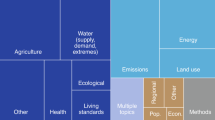Abstract
Integrated assessments (IAs) and integrated assessment models (IAMs) arerecent responses to the inter-disciplinary challenges provided by complexglobal environmental issues such as atmospheric change. This paper discussesan array of integrated assessments, providing an overview of the role of IAsas bridges or foundations for ’epistemic communities‘. Formal as well associal, political, and ethical issues are presented. As well as a definition of anIA and an IAM, different forms and approaches of current or proposed IAsare reviewed. Particular stress is laid on the need to maintain the integrity ofthe diverse components of an IA. Finally, reference is made to the need tounderstand the underlying ethical and normative concerns that have promotedthe current interest in IA.
Similar content being viewed by others
References
Alcamo, J. (ed.): 1994, IMAGE 2.O: Integrated Modelling of Global Climate Change, Kluwer Academic Publishers, Dordrecht.
Alcamo, J. et al.: 1987, ‘Acidification in Europe: A Simulation Model for Evaluating Control Strategies’, Ambio 19, 232–45.
Beanlands, G. E. and Duinker, P. N.: 1983, ‘An Ecological Framework for Environmental Impact Assessment in Canada’, FEARO, Env. Canada, Ottawa, Ont., 132 pp.
Clark, N.: 1990, ‘The international diffusion of biotechnology: some ideas for a common research framework’ in: D. F. DeAlmeida (ed.), Science Policy Research: Implications and Applications, Pinter Publishers, London.
Clark, W. C. (ed.): 1990, Useable Knowledge for Managing Global Climatic Change, The Stockholm Institute, Stockholm.
Davidson, O. et al.: 1966, ‘Integrated assessment of climate change: an overview and comparison of approaches and results’, Contribution of Working Group III to the IPCC Second Assessment Report, Cambridge: University Press.
Dowlatabadi, H. and Morgan, M. G.: 1993, ‘Integrated Assessment of Climate Change’, Science 259 (26 March), 1813–1932.
Edwards, P. N.: 1996, ‘Editorial Essay: Global Comprehensive Models in Politics and Policymaking’, Climatic Change 32, 149–161.
Funtowicz, S.: 1995, UNEP/SCOPE. See full reference.
Grenon, M. and Batisse, M.: 1989, The Blue Plan, Oxford University Press for UNEP/-BP/RAC, New York.
Haas, P.: 1990, ‘Obtaining International Environmental Protection through Epistemic Consensus’, Millenium 19, 347–364.
IIASA: 1989, Activity Plan: Summary, International Institute for Applied Systems Analysis, Laxenburg, Austria.
Jacoby, H. D. et al.: 1996, ‘QELRO Impacts: Domestic Markets, Trade, and Distribution of Burdens, and Climate Change’, Climate Change Analysis Workshop, Springfield, Virginia, U.S.A. (June 6–7).
Laitner, J. A.: 1996, ‘Energy Efficiency as both a Climate Action Strategy and an Economic Development Initiative for the United States’, Climate Change Analysis Workshop, Springfield, Virginia, U.S.A. (June 6–7).
Lave, L. B.: 1988, ‘The Greenhouse Effect: What Government Actions are Needed’, Journal of Policy Analysis and Management 3, 460–470.
Meadows, D. H.: The Limits to Growth: A Report for the Club of Rome's Project on the Prediction of Mankind, Universe Books, New York, 205 pp.
Morgan, M. G. and Dowlatabadi, H.: 1996, ‘Lessons from Integrated Assessment of Climate Change’, Climatic Change (in press).
Munn, R. E. (ed.): 1990, Report of a Workshop: The Case for Integrated Models of Acidic Deposition in Canadian Environmental Policy Making. Institute for Environmental Studies, Toronto, Environmental Monograph No. 10.
Munn, R. E. (ed.): 1995, Atmospheric Change in Canada: Assessing the Whole as well as the Parts, Institute for Environmental Studies and Environment Canada, Toronto.
Nordhaus, W. D.: 1994, Managing the Global Commons: the Economics of Climate Change, MIT Press, Cambridge MA.
Parry, M. L., Carter, T. R. and Konjin N. T. (eds.): 1988, The Impact of Climatic Variations on Agriculture (2. vols), Kluwer Academic Publishers, Dordrecht for UNEP/IIASA.
Parson, E. A.: 1995, ‘Integrated Assessment and Environmental Policy Making’, Energy Policy 23(4/5), 463–475.
Prinn, R. et al.: 1996, ‘Integrated Global System Model for Climate Policy Analysis: 1 Model Framework and Sensitivity Studies’, MIT Joint Program on the Science and Policy of Global Change, Report No. 7, Cambridge MA.
Rosenberg, N. J. (ed.): 1993, ‘Towards an Integrated Assessment of Climate Change: the MINK Study’, Climatic Change 24, 1–173.
Rothman, D. S. and Robinson, J. B.: 1996, ‘Growing Pains: A Conceptual Framework for Considering Integrated Assessments’, Environmental Monitoring and Assessment 46, 23–43.
Rotmans, J.: 1990, IMAGE: An Integrated Model to Assess the Greenhouse Effect, Kluwer Academic Publishers, Dordrecht.
SCOPE 5: 1975, 1979, Environmental Impact Assessment: Principles and Procedures SCOPE/John Wiley, Chichester, U.K., 1st and 2nd editions, 208 pp.
UNEP/SCOPE: 1995, Pantanal Regional Workshop: Project on Integrated Adaptive Ecological/Economic Modelling and Assessment (4–10 November). Draft Report.
Voyer, R. D. and Murphy, M. G.: 1984, Global 2000: Canada — A view of Canadian economic development prospects, resources and the environment, Pergamon, Toronto.
Walters, C. J.: 1974, ‘An Interdisciplinary Approach to Development of Watershed Simulation Models’, J. Technol. Forecasting.
Author information
Authors and Affiliations
Rights and permissions
About this article
Cite this article
Timmerman, P., Munn, R.E. THE TIGER IN THE DINING ROOM: DESIGNING AND EVALUATING INTEGRATED ASSESSMENTS OF ATMOSPHERIC CHANGE. Environ Monit Assess 46, 45–58 (1997). https://doi.org/10.1023/A:1005735902044
Issue Date:
DOI: https://doi.org/10.1023/A:1005735902044




